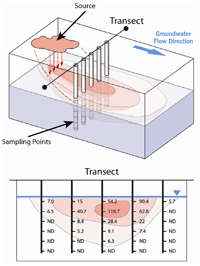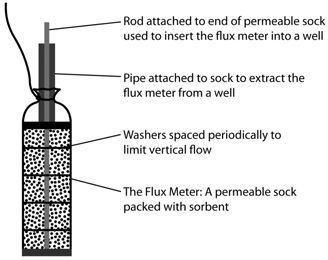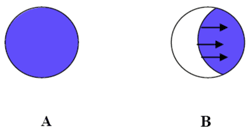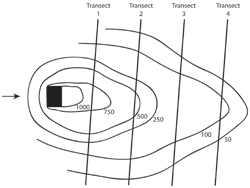Mass Flux
Mass Flux Measurement
Several techniques are available for measuring mass flux in an aquifer.
Monitoring Well Transects Method
In the monitoring well transect method, monitoring wells (or direct push sampling points) are constructed in series perpendicular to the groundwater flow. The wells should cover the entire cross-section of the plume. The monitoring wells can be either single (long well screen) or multilevel.
Single wells will provide an average for their location and do not identify hot spots. Multilevel wells show better contaminant distribution (Figure 5). The uncertainty of the measurement is directly related to sample density.
Mass flux is typically calculated using the Theissen polygon method (ITRC 2010). In this method, the transect is divided into polygons or rectangles centered upon the contaminant concentration values. To calculate the flux, three values are needed: contaminant concentration, hydraulic conductivity within the polygon area, and hydraulic gradient within the polygon area.
The method that yields the least uncertainty is to use closely spaced contaminant concentrations to represent smaller cross-sectional areas; use hydraulic conductivity values that are measured for each polygon and hydraulic gradient values measured in each polygon. This method is also very expensive.
One assumption that can be made to reduce cost is to assume that the hydraulic gradient across a transect is not appreciably different with depth.
A second assumption that can be made to reduce cost is to assign hydraulic conductivity by predominant soil type in the polygon. While less accurate than direct measurement, it will provide some accounting for potential soil heterogeneity in the transect.
The most uncertain method for calculating mass flux is to use one hydraulic conductivity value for the whole transect.
As a cautionary note, sampling densities from points along a transect are commonly less than 1 percent of the total flow through the transect (ITRC 2010). Concentrations of contaminants over a 30-cm vertical interval can range over four orders of magnitude (Guilbeault et al. 2005).
ITRC (2010) provides an extensive discussion on transect mass flux and mass discharge calculations, accuracy, and uncertainty.
References:
The integral pumping test (IPT) employs the effect of the increasing size of the capture zone during a pumping test. Simultaneously with the pumping time, multiple contaminant concentration measurements are performed. The change in concentrations with time can be used to estimate the spatial distribution of the contaminants and the total mass flow rate of a contaminant plume in groundwater (Gzyl et al. 2011).
In simple cases, the capture zone of a single well comprises the whole area downgradient of a source zone after a certain pumping time. The quality of groundwater in the specific time interval corresponds with the spatial integral quality in the capture zone (Gzyl et al. 2011).
As practical experience shows, covering the whole downgradient area of a potential contaminated site with one pumping test usually is not possible. On the one hand, plume locations usually cannot be estimated precisely enough for optimal location of a pumping well. On the other hand, very long pumping times would be necessary to achieve a quasi-steady state situation (Gzyl et al. 2011).
For larger sites, control planes from multiple pumping wells can be used. Control planes are vertical cross-sections through the groundwater aquifer. The most important results related to control planes are contaminant mass flow rates across the control plane as well as average and maximum concentrations. These values are supposed to characterize the emission and source strength of the contaminant from the investigated source zone(s). It is important, therefore, to ensure that control planes:
- Are placed downstream from the investigated source zone(s).
- Cover the total width of groundwater stream that might be contaminated by the source zone(s).
- Are as much as possible perpendicular to groundwater flow direction.
The scale of application and the distance between downgradient control planes is a key issue. Aiming at a precise quantification of the source strength not influenced by natural attenuation processes along the flow path requires the first control plane to be located closely downstream of the potential sources of pollution. Care should be taken in pumping the wells in this control plane to avoid increasing contaminant dissolution in the source zone artificially. Additional downgradient control planes to delineate the plumes and to quantify natural attenuation processes should be defined according to the contaminants considered (Ertel and Schollenberger 2008).
Using the sampling and analysis of groundwater in the specified time intervals during the pumping (the multiple concentration measurement), the information of the quality of groundwater related to the specific capture zone can be determined. The time curve of contaminant concentration indicates the occurrence of an important variation in groundwater quality (the occurrence of the contaminant plume) in the capture zone of pumping (Gzyl et al. 2011).
The concentration time series yields information on the position and extent of the contaminant plume(s) as well as on the concentration of the target substances in the plume(s).The typical examples of the time concentration curves resulting from the position of the pumping well and the spatial occurrence of contaminant plume are illustrated in the following scheme (Gzyl et al. 2011).

Figure 6. Characteristic hydrograph curve for concentrations with different capture zone geometries (acc. to Holder and Teutsch, 1999)
Source: Gzyl et al. 2011
With an inverse mathematical method, the possible distribution of contaminants in the capture zone of a well can be calculated. This allows calculation of the average contaminant concentration (CAV) in the capture zone and mass flow rates QA*CAV (Gzyl et al. 2011). Software has been developed specifically for IPT; however, a numerical model such as Visual MODFLOW also should be employed for aquifer simulations.
Integral pumping tests are generally applicable within a broad range of hydrogeological and technical conditions. Key criteria are the extension of the potential plumes related to the width of captures zones that can be achieved by the pumping tests.
| Range of Applications Based on Hydraulic and Chemical Criteria | ||
|---|---|---|
| Range of IPT Application | From | To |
| Hydrogeological Conditions | ||
| Hydraulic Coefficient - kf(m/s) | 10-6 | 10-2 |
| Hydraulic gradient | < 0.01 | |
| Effective Porosity ne | < 0.2 | |
| Pollutants | ||
| Soluble in Water | Major ions, inorganic salts, naphthalene, benzene, chlorinated hydrocarbons, etc. | |
| Low Sorption, Low Degradability | ||
| Octanol-Water Partition Coefficient Kow | logKow < 3 | |
Integral pumping tests are not useful in situations when only very small widths of capture zones can be achieved. Low permeabilities (kf < ca. 1E-6 m/s) give unfavorable conditions for this method. Another disadvantage is a very high yield (Kf > ca.1E-2 m/s). At high pumping rates, considerable amounts of water must be cleaned and/or discharged, which increases costs. Furthermore, narrow plumes of contaminants with low risk-based concentration values (e.g., PAHs or pesticides with MCLs in the parts per trillion range) might not be detectable due to dilution effects combined with available analytical detection limits (Ertel and Schollenberger 2008).
References:
Prinzip des neuen Immissionsmessverfahrens, Anwendung der Immissionsmessung im Neckartal
T. Holder and G. Teutsch.
Integrale Altlastenerkundung im Stuttgarter Neckartal, Schriftenreihe des Amtes fur Umweltschutz, Stuttgart, 4(1999).
An Analytical Quantification of Mass Fluxes and Natural Attenuation Rate Constants at a Former Gasworks Site (Abstract)
A. Bockelmann, T. Ptak, and G. Teutsch.
Journal of Contaminant Hydrology 53(3-4):429-453(2001).
![]() Application of Integral Pumping Tests to Investigate the Influence of a Losing Stream on Groundwater Quality
Application of Integral Pumping Tests to Investigate the Influence of a Losing Stream on Groundwater Quality
AS. Leschik, A. Musolff, R. Krieg, M. Martienssen, M. Bayer-Raich, F. Reinstorf, G. Strauch, and M. Schirmer.
Hydrology and Earth System Sciences Discussions 6(3):4209-4232(2009).
A Field Comparison of BTEX Mass Flow Rates Based on Integral Pumping Tests and Point Scale Measurements (Abstract)
M. Dietze and P. Dietrich.
Journal of Contaminant Hydrology 122(1-4):1-15(2011).
Identifying Sources of Chlorinated Aliphatic Hydrocarbons in a Residential Area in Italy Using the Integral Pumping Test Method (Abstract)
L. Alberti, S. Lombi, and A. Zanini.
Hydrogeology Journal 19(6):1253-1267(2011).
Integral Quantification of Contaminant Mass Flow Rates in a Contaminated Aquifer: Conditioning of the Numerical Inversion of Concentration-Time Series (Abstract)
M. Herold, T. Ptak, M. Bayer-Raich, T. Wendel, and P. Grathwohl.
Journal of Contaminant Hydrology 106(1-2):29-38(2009).
Integral Pumping Tests for the Characterization of Groundwater Contamination
M. Bayer-Raich.
Eberhard-Karls-Univ. Tuebingen, Germany. Ph.D. dissertation, 123 pp, 2004.
Integral Pumping Test Analyses of Linearly Sorbed Groundwater Contaminants Using Multiple Wells: Inferring Mass Flows and Natural Attenuation Rates (Abstract)
M. Bayer-Raich, J. Jarsjo, R. Liedl, T. Ptak, and G. Teutsch.
Water Resources Research 42(8):W08411(2006).
Investigation of Contaminant Mass Fluxes and Reactive Transport Modelling of Heterocyclic Hydrocarbons at Former Gasworks Sites
Maria Herold.
Georg-August-Univ. zu Goettingen, Germany. Ph.D. dissertation, 128 pp, 2009.
Investigation of Sewer Exfiltration Using Integral Pumping Tests and Wastewater Indicators (Abstract)
S. Leschi, A. Musolff, M. Martienssen, R. Krieg, M. Bayer-Raich, F. Reinstorf, G. Strauch, and M. Schirmer.
Journal of Contaminant Hydrology 110(3-4):118-129(2009).
![]() Risk Assessment Models and Uncertainty Estimation of Groundwater Contamination from Point Sources
Risk Assessment Models and Uncertainty Estimation of Groundwater Contamination from Point Sources
Mads Troldborg.
Technical University of Denmark, Kgs. Lyngby. Ph.D. dissertation, 105 pp, 2010(2009).
![]() Towards Optimal Sampling Schedules for Integral Pumping Tests (Abstract)
Towards Optimal Sampling Schedules for Integral Pumping Tests (Abstract)
S. Leschik, M. Bayer-Raich, A. Musolff, and M. Schirmer.
Journal of Contaminant Hydrology 124(1-4):25-34(2011).
Existing pump and treat systems can be used to calculate mass discharge, provided they capture the entire plume. They cannot be used to determine flux through high discharge areas or hotspot locations. If the system has multiple pumping wells, sampling each well may yield information on where high contaminant zones are. If the system can be turned off long enough to allow natural flow gradients to re-establish themselves, then the individual wells can be used for performing an integral pumping test (ITRC 2010).
Reference
![]() Use and Measurement of Mass Flux and Mass Discharge
Interstate Technology & Regulatory Council (ITRC), Integrated DNAPL Site Strategy Team.
Use and Measurement of Mass Flux and Mass Discharge
Interstate Technology & Regulatory Council (ITRC), Integrated DNAPL Site Strategy Team.
MASSFLUX-1, 154 pp, 2010.
The Passive flux meter (PFM) measures both groundwater flux and contaminant flux. The PFM is a self-contained permeable unit (nylon mesh tube) that is inserted into a well or boring such that it intercepts groundwater flow but does not retain it. The interior composition of the meter is a matrix of hydrophobic and hydrophilic permeable sorbents that retain dissolved organic and inorganic contaminants present in fluid intercepted by the unit. The sorbent matrix is also impregnated with known amounts of one or more fluid-soluble "resident tracers." These tracers are leached from the sorbent at rates proportional to the fluid flux (ESTCP 2006d). The aquifer permeable unit should be the same length as the screened interval.
After a specified period of exposure to groundwater flow, the flux meter is removed from the well or boring. Next, the sorbent is carefully extracted to quantify the mass of all contaminants intercepted by the flux meter and the residual masses of all resident tracers. The contaminant masses are used to calculate cumulative and time-averaged contaminant mass fluxes, while residual resident tracer masses are used to calculate cumulative or time-average fluid flux. Depth variations of both water and contaminant fluxes can be measured in an aquifer from a single flux meter by vertically segmenting the exposed sorbent packing and then analyzing for resident tracers and contaminants. At any specific well depth, an extraction from the locally exposed sorbent thus yields the tracer remaining and the mass of contaminant intercepted. Multiple tracers with a range of partitioning coefficients are used to determine variability in groundwater flow with depth that could range over orders of magnitude. These data are used to estimate local cumulative water and contaminant fluxes (ESTCP 2007).
Provided well construction does not change the groundwater gradient and no naturally occurring vertical gradient is present, the measurement of flux at a given screen segment should represent aquifer conditions opposite the screen (Vroblesky 2001).
Successful demonstrations of the technology have focused on tetrachloroethene, trichloroethene, dichloroethene, vinyl chloride, ethylene, methyl tertiary butyl ether, and perchlorate; however, because the sorbent is chosen to match the chemical properties of the contaminants of concern, the method should apply to many other chemicals. Activated charcoal was the sorbent of choice for the above demonstrations.
References
![]() Demonstration and Validation of a Fractured Rock Passive Flux Meter
Demonstration and Validation of a Fractured Rock Passive Flux Meter
Hatfield, K.
ESTCP Project ER-200831, 195 pp, 2015
A new closed-hole passive sensing technology for fractured media, the Fractured Rock Passive Fluxmeter (FRPFM), provides simultaneous measurement of (1) the presence of flowing fractures; (2) the location of active or flowing fractures; (3) active fracture orientation, i.e., dip and azimuth; (4) direction of groundwater flow in each fracture; (5) cumulative magnitude of groundwater flux in each fracture; and (6) cumulative magnitude of contaminant flux in each fracture. Other technologies exist to measure (1), (2) and (3) above; however, the FRPFM is the only technology that also measures (4), (5) and (6). Based upon 16 field tests conducted at two chlorinated solvent-contaminated fractured rock sites, the FRPFM achieved the standard in each of the six quantitative performance objectives. A key distinction is that the FRPFM generates high-resolution measures over a specified interval and is best used for characterizing targeted borehole depth intervals, not for screening conditions over an entire borehole.
![]() Demonstration and Validation of a New Device for Measuring Water and Solute Fluxes at NASA LC-34 Site
Demonstration and Validation of a New Device for Measuring Water and Solute Fluxes at NASA LC-34 Site
ESTCP Project ER-0114, 172 pp, 2006.
![]() Diagnostic Tools for Performance Evaluation of Innovative In-Situ Remediation Technologies at Chlorinated Solvent-Contaminated Sites. Final Report: Fort Lewis
Diagnostic Tools for Performance Evaluation of Innovative In-Situ Remediation Technologies at Chlorinated Solvent-Contaminated Sites. Final Report: Fort Lewis
M. Kavanaugh, R. Deeb, and E. Hawley.
ESTCP Project ER-200318, 134 pp, 2011.
![]() Field Demonstration and Validation of a New Device for Measuring Water and Solute Fluxes at CFB Borden
Field Demonstration and Validation of a New Device for Measuring Water and Solute Fluxes at CFB Borden
K. Hatfield, M.D. Annable, and P.S.C. Rao.
Environmental Security Technology Certification Program, Project ER-0114, 153 pp, 2006.
![]() Field Demonstration and Validation of a New Device for Measuring Water and Solute Fluxes at Naval Base Ventura County (NBVC), Port Hueneme, CA: Revised Final Report (Version 2)
Field Demonstration and Validation of a New Device for Measuring Water and Solute Fluxes at Naval Base Ventura County (NBVC), Port Hueneme, CA: Revised Final Report (Version 2)
K. Hatfield, M.D. Annable, and P.S.C. Rao.
Environmental Security Technology Certification Program, Project 0114, 113 pp, 2006.
Flux-Based Assessment at a Manufacturing Site Contaminated with Trichloroethylene (Abstract)
N.B. Basu, P.S.C. Rao, I.C. Poyer, M.D. Annable, and K. Hatfield.
Journal of Contaminant Hydrology 86(1-2):105-127(2006).
Groundwater and contaminant fluxes were measured with the passive flux meter (PFM) technique in wells along a longitudinal transect passing approximately through the centerline of a TCE plume at a former manufacturing plant. Two distinct zones of hydraulic conductivity were identified from the measured groundwater fluxes that would significantly affect any remediation technology used at the site. The flux-averaged TCE concentrations estimated from the PFM results compared well with existing groundwater monitoring data. At least 800 kg of TCE was estimated to be present in the source zone. The TCE mass discharge across the source control plane was used to estimate the source strength (365 g/day), while mass discharges across multiple downgradient control planes were used to estimate the plume-averaged TCE degradation rate constant (0.52/year). The mass discharge approach provides a more robust and representative estimate than thecenterline approach; the latter uses only data from wells along the plume centerline while the former uses all wells in the plume.
General Analytical Treatment of the Flow Field Relevant to the Interpretation of Passive Fluxmeter Measurements (Abstract)
H. Klammler, K. Hatfield, M.D. Annable, E. Agyei, B.L. Parker, J.A. Cherry, and P.S.C. Rao.
Water Resources Research 43:W04407(2007).
Magnitude and Directional Measures of Water and Cr(VI) Fluxes by Passive Flux Meter
T. Campbell, K. Hatfield, H. Klammler, M. Annable, and P.S.C. Rao.
Environmental Science & Technology 40(20):6392-6397(2006).
A New Approach to Measuring the Direction of Horizontal Groundwater Flow (Abstract)
H. Klammler, K. Hatfield, and M. Annable.
Eos. Trans. AGU 84(46) Fall Meet. Suppl., Abstract H21D-0857, 2003.
A passive flux meter (PFM) has been developed to simultaneously measure the magnitudes of ground water and contaminant fluxes in porous media. The PFM consists of permeable sorptive media in the shape of a homogeneous cylinder that is inserted into a borehole and that exactly fits the diameter of the well screen. The PFM, which initially contains a known amount of a resident tracer, thus intercepts ground water and contaminant flow, causing the partial elution of the resident tracer from the PFM and the sorption of contaminants onto the PFM. Quantitative analysis of the PFM for the amount of resident tracer remaining on the PFM media and the amount of contaminant sorbed onto the PFM after exposure to ground water and contaminant flow allows for the determination of the magnitudes of ground water and contaminant fluxes. This paper presents two modified configurations of the PFM and compares their capability for measuring the horizontal flow direction simultaneously to the magnitudes of ground water and contaminant fluxes.
Passive Fluxmeters: Application as a Characterization/Monitoring Tool for Monitored Natural Attenuation of Chlorinated Solvents
K. Vangelas, B.B. Looney, K. Hatfield, M.D. Annable, J. Cho, and M.R. Millings.
WSRC-STI-2006-00315, 47 pp, 2006.
Contaminant mass flux is generally defined as the mass of contaminant passing through a unit area per unit time, while the integrated mass flux or contaminant mass discharge is the spatial integration of the contaminant flux over a control plane. This report presents results of a research project in which passive fluxmeters (PFMs) were used to measure changes of chlorinated ethene fluxes along the axis of a ground-water contaminant plume.
Transects Based on Contaminant Contours
Data from existing monitoring wells are often used to create contaminant contour maps which represent the best estimate of the plume shape and contaminant distribution. In general, the individual contour is taken to be the integrated concentration of contaminant across the length of the well screen upon which it was calculated. Flux polygons are constructed based on the points where the transect intersects the contour line.
ITRC (2010) states that this method may have more uncertainty than high-density multilevel transect data because contours that do not sufficiently consider the site-specific geology and controlling preferential pathways often seen in contaminant transport can be misleading, whether prepared by hand or by computer. The contours also must take into account vertical variations in flow and transport pathways and distribution. If the monitoring well network is sufficiently dense, useful mass flux estimates can be generated. When the screened interval of the wells in the monitoring network intercepts all or a large fraction of the contaminated plume thickness, and when the sample that is collected represents a flow-weighted average concentration, the method will be more accurate.
Numerical (e.g., MODFLOW/MT3D) and analytical (e.g., BIOSCREEN, BIOCHLOR, REMChlor) solute transport models can be used to calculate mass flux. The Mass Flux Toolkit is freeware developed by the Department of Defense (DoD) to aid in calculating and interpreting mass flux data.
The different types of models are based on different assumptions and calculation techniques. Analytical models make use of simplifying assumptions such as uniform one-dimensional flow fields, simple source characteristics, and other factors that make these models useful for screening or planning purposes. The accuracy of mass flux data from numerical models would, as expected, be very dependent on the accuracy of the input data for flow and contaminant concentration and mass (ITRC 2010).
The amount of data available to input into the model is also significant. If insufficient data are available to generate node sizes appropriate to the local geology and hydrogeology, the model may oversimplify site conditions. Care must also be taken during model uncertainty assessment and calibration to ensure site conditions are accurately represented (ITRC 2010).
Reference
![]() Use and Measurement of Mass Flux and Mass Discharge
Use and Measurement of Mass Flux and Mass Discharge
Interstate Technology & Regulatory Council (ITRC), Integrated DNAPL Site Strategy Team.
MASSFLUX-1, 154 pp, 2010.
The Mass Flux Toolkit, developed for DoD's ESTCP program, is an easy-to-use software tool that enables users to learn about different mass flux approaches, calculate mass flux from transect data, and apply mass flux values to manage groundwater plumes. The Toolkit presents the user with three main options:
- A module to calculate the total mass flux across one or more transects of a plume, calculate the uncertainty in the calculation, and plot mass flux versus distance to show the effect of remediation/impact of natural attenuation processes.
- A module allowing users to perform critical dilution calculations for plumes approaching production wells or streams. An additional feature calculates the capture zone of the supply well and compares it to the transect used to calculate the mass flux, directing the user to alter the transect dimensions if the transect does not encompass the capture zone.
- A module that provides a review of theory and methods of estimating mass flux.










